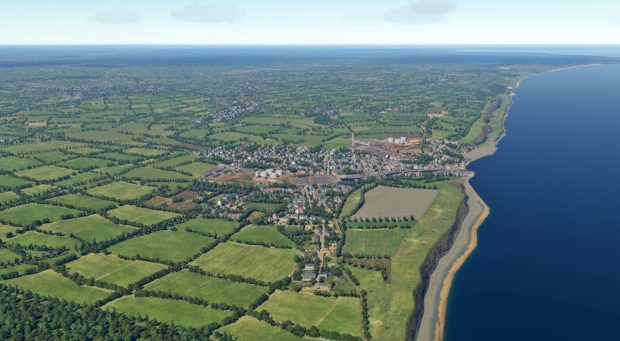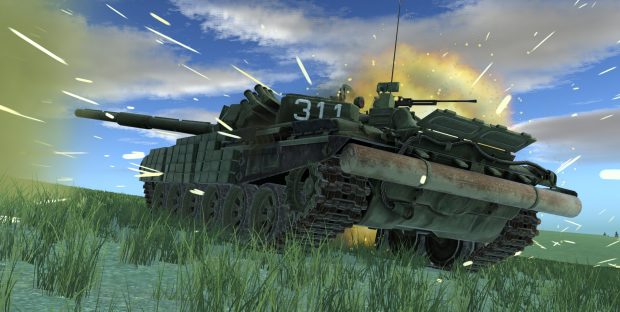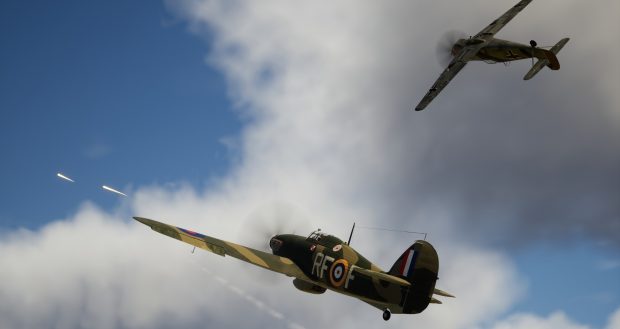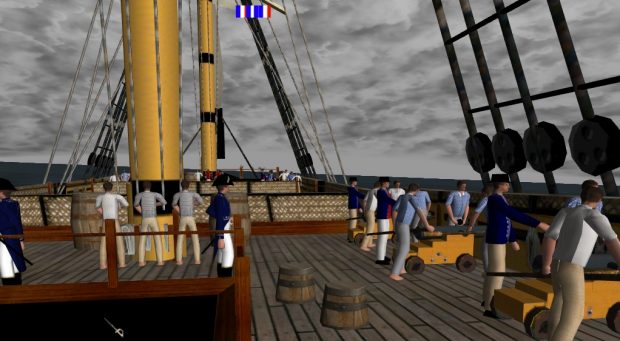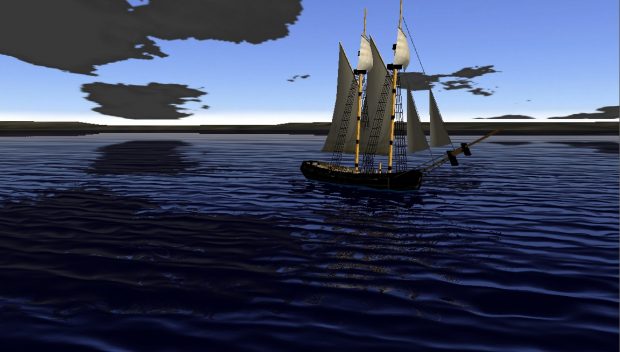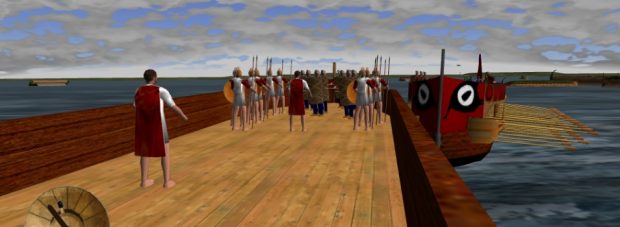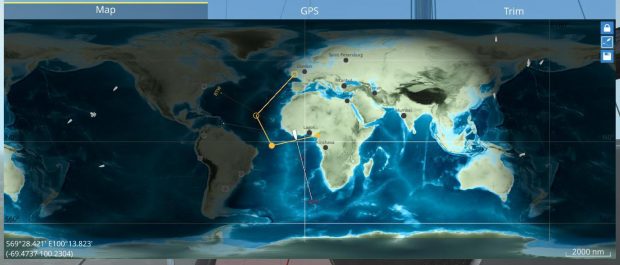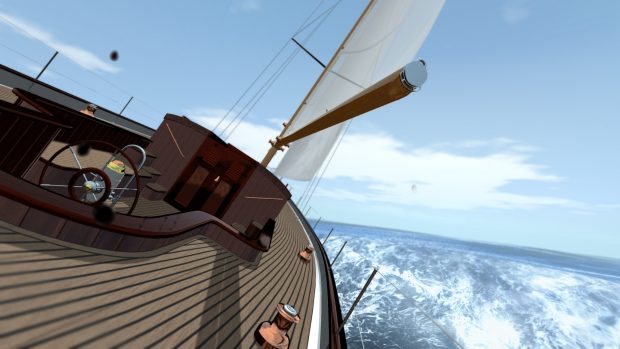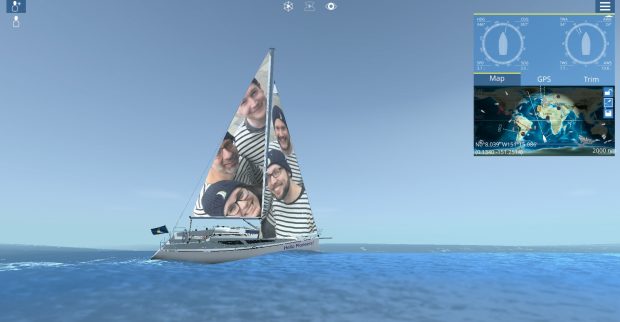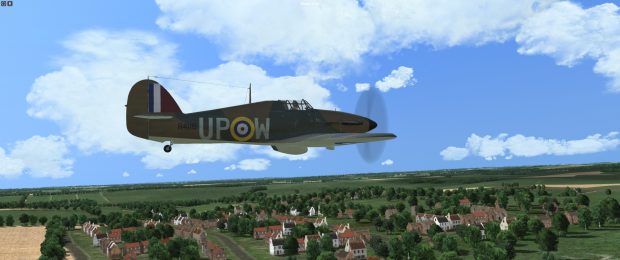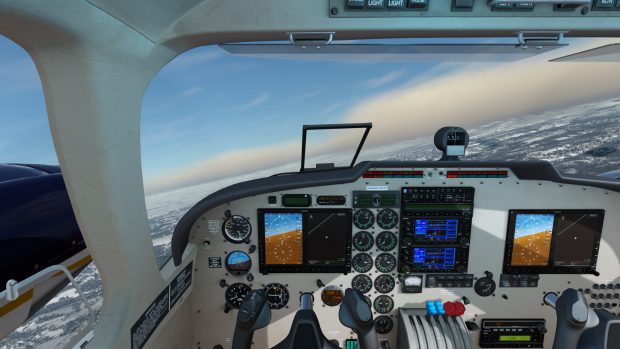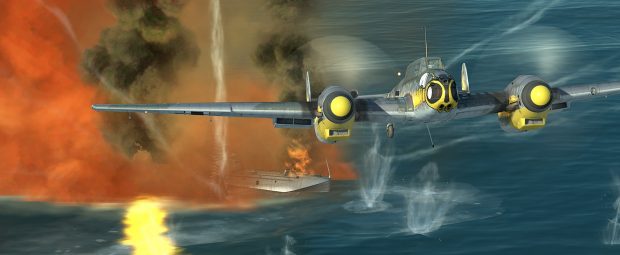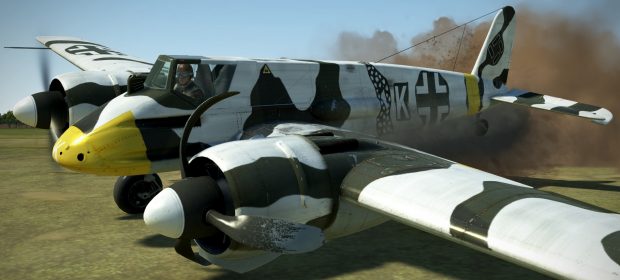The Flare Path: How's it going?
Sitreps from sim studios
Operation Pump Handle went rather well, all things considered. Of the ten peanut-powered mechanical magpies dispatched on Monday morning, nine returned home with sim developer status reports in their leg canisters. Only Domino (destination Deadstick) is still out there somewhere. If you live in the Guildford area and have recently had a smoke or spark emitting Pica pica visit your bird table, please let me know.
DCS World acquired a French pied-à-terre, a Swedish accent, and a talent for hovering without the aid of rotor blades last year. In 2018, if all goes to plan, it will undergo dramatic plastic surgery, gain a foothold in the Middle East, and whelp new Warthog-calibre flyables like the F/A-18C Hornet.
Matt Wagner: “2017 for DCS World marked a substantial increase in the amount of new content, but we also focused on technology development for the future. The biggest change was fleshing out the DCS World War II environment. This primarily consisted of the release of the DCS: Normandy 1944 Map and Assets Pack, but also World War II campaigns based over Normandy in 1944. This was an important step for us to provide a proper home to our World War II warbirds. On the modern-day front, we saw the release of the AJS-37 Viggen, AV-8B Night Attack, Su-33, the NS 430 GPS system, and numerous campaigns, mission editor enhancements, and updates to existing products.
In parallel though, we devoted a lot of resources to address our biggest challenge… multiple DCS World versions based on the map being used. This is being resolved with DCS World 2.5, which will merge all DCS World versions into a single version. 2.5 will also feature a new, greatly-updated Caucasus map, new effects, improved performance, and new virtual reality features.
Moving into 2018, we see it as a sea-state change for us. By the end of January, DCS World 2.5 will be released and the F/A-18C Hornet will be released into Early Access by the end of March 2018. Also internally, Eagle Dynamics is developing the Yak-52 (based on a professional training contract) and a Strait of Hormuz map (a great home for many of our modern-day aircraft). Third Party projects are growing and are a vital aspect of DCS World. They will bring many exciting new aircraft to DCS World in 2018: F-14 Tomcat, F-4E Phantom II, Mi-24P Hind, JF-17, MiG-19, Bo-105, I-16, Christen Eagle II, and the C-101 CC. With the Hornet, and other aircraft carrier aircraft like the Tomcat and Su-33, new Russian and American aircraft carriers are also coming to DCS World in 2018.
The overall goal of DCS World in 2018 remains on creating a large stable of aircraft from World War II to modern-day with supporting maps around the world and over various time periods. We see 2018 as furthering this goal to build a more inclusive and realistic simulation environment for combat aviation enthusiasts.”
* * *
For simmers who like their armour recreations swastika-free, multiplayer amenable, and realistic enough to double as military training tools, 2017 wasn't without frustrations. Below, the commendably frank Nils Hinrichsen describes what happens when a relatively small studio is forced to choose between fulfilling bread-and-butter defence contracts and delivering ambitious engine improvements to leisure customers.
“One of the things we've been working on in 2017 was the replacement of all of Steel Beasts' foliage artwork with new grass and trees. This is intended to complement the release of the new high-res terrain engine which is now scheduled for this year.
I could explain in depth (and bore everyone to death in the process) why the terrain engine delays happened. At the end of the day it was a combination of underestimating the cascading effect of changing one fundamental design parameter - increasing the ground resolution by a factor of 512 - and the desire of our users to see established workflows maintained (like last-minute changes on a map when designing a scenario). This was perfectly valid of course but difficult to implement when inflated file sizes meet rural low-bandwidth internet connections. Not everybody lives in the city.
Anyway, these technical constraints forced us to become more creative with the way that we're managing resources, which in turn required user interface design changes... and we still have other projects to work on. So eventually the window of opportunity for a release in September '17 closed, and all that we could do was to at least wrap up all the bug fixes that were made during the last summer's beta test phase which is now 4.023 that we released last month.
We are now in a phase where we have a number of contractual obligations to meet so I'm not entirely sure when we will find the time for another attempt to release the 4.1 version with the high-res terrain engine. What I can say is that 4.1 isn't in a bad shape, just not quite ready for a public release. A part of the team will continue to work on it, and once it reaches maturity we will push it out. It's just that we can't have the full team work exclusively on this right now. That's the downside of our hybrid business. But then again, without that business model there wouldn't be a Personal Edition of SB Pro to begin with.”
* * *
Atomic Jelly swapped germs for Germans last spring. On finishing the Fantastic Journeyish Project Remedium, they embarked on 303 Squadron, a Battle of Britain sim with a pronounced Polish slant, a strikingly hands-on approach to aircraft maintenance and repair, and an unusually detailed recreation of RAF Northolt at its core. No-one could accuse head of studio Bartosz Rakowski and designer Wojtek Cajgner of conceptual timidity. If their daring Finest Hour experiment comes off, it's sure to be one of 2018's most memorable military games.
Bartosz: “Last year was one huge battlefield, on which I think, despite many tough clashes, we ultimately triumphed. One of our main achievements was the release of our very first game, Project Remedium. To create a realistic story of a nanobot operating inside the human body required a lot of very demanding, but also extremely interesting and rewarding research on medicine and pharmacology. To see our creation out there, available globally, was very gratifying. We even had it distributed in a boxed edition in Poland.”
Wojtek: “Project Remedium was a challenge, but 303 Squadron: BoB is a much bigger project. Our team has done an incredible amount of research, examined a wealth of reference material, even talked to the members of pilot’s families. Realism is essential if you want to portray the life of pilots and ground crew - their daily struggles - and reconstruct their equipment. It's vital if you want to create a game that can also serve as a tribute. We want to tell the incredible story of 303 Squadron and to make it interesting to both history fans and to those simply out for excitement. How better to achieve this than through fierce battles and realistic mechanics?”
Bartek: “Flight modelling took probably half of 2017. It required an in-depth study of aeronautics. Implementing the equations was far from easy. The challenge of making everything work in real-time required some compromises; for example we couldn’t just calculate all the forces acting on the wings at every single point. Instead, we found several key points that provide optimal, quickly processable results. Alongside our full FM we've also added an arcade mode of control where the plane follows the mouse cursor. This should make 303 accessible and entertaining for less experienced players.”
* * *
Five months have passed since I last chatted with Richard Taylor, an aspiring game developer whose dreams, like Neptune's trident, are three-pronged and tangled with seaweed. Are gamers who know their port from their starboard and their aft from their elbow any closer to playing Ship of the Line, Dreadnought, and Trireme?
“There was one big development in the latter half of 2017. I got to try out Ship of the Line on a modern PC under Windows 10. The good news is it ran. The bad news is it didn't run very well. It looks as if the old version of the graphics libraries used by JME1 (the 3D engine I'm using) aren't quite up to scratch, so while on the whole everything still worked, there were some graphics and texture glitches. So I faced a choice - spend time trying to sort out these glitches on the now outdated JME1, or take the time to port everything over to JME3 (the latest version, which I had previously decided not to use). After a little thought it seemed clear that going to JME3, though the painful choice, is also the right one. So I am now midway (I hope at least midway) through this rather tedious process; JME3 is just different enough that basically all the graphics code has to be reworked - fortunately the underlying game logic is unaffected.
Before I started on this, I had also been following the (perhaps ill-advised) path of trying out other games that can be built on the same engine. I mentioned my WW1 flight simulator before, and I played around with a WW2 (Battle of Britain) version also, as well as doing some more work on a Battle of Waterloo proof of concept (the underlying game mechanisms work surprisingly well for land warfare). These side projects will have to go on hold though until the JME3 translation is done (and then they too will need translating - but the hard work should all be done for Ship of the Line).
One positive thing is that a modern PC with JME3 is indeed much faster than what I was working with before. My first JME3 testbed put 1000 aircraft (I used the WW1 version for this) in the sky at once with no problems - an impressive sight!
Given the above, yes I'm pretty happy with how things are now progressing. Of course translating the game is a largely mechanical process, without really adding anything new, but on the plus side JME3 has some nice graphical features which I hope to incorporate (smoke, water and such like), and I hope to be able to handle much larger fleets. It is a load of extra work I could have done without, but I think it is for the best.
I've been following some of the 'competition' with interest too. Last time we spoke my Trireme game was unique in the field - now two Age of Oars games (Mare Nostrvm and Trireme Commander) have come out in quick succession, and suddenly triremes are old news. My games take a very different approach to both these two though, so I don't think that's a problem.
Major challenges in the coming year? The main thing is to get the translation done. There are some custom features I can't copy over directly into JME3 (the animated sea surface, the cloth flags) so these will need either changing, or rewriting from scratch. Then when all this is done, it's just on to the really hard job - actually finishing the game. Making that final step from prototype to reasonably polished final version is bound to be time-consuming, and hard. As a solo developer working for my own enjoyment I have the massive disadvantage of having no deadlines, and nobody cracking the whip - these things are sometimes necessary to finally get things finished.
I'm reluctant to offer an ETA. I hope to get the JME3 translation done by the end of February. Then in theory, just some polish and I'm done! Definitely at least one of the trio will be finished during 2018 - that is my New Year's resolution.
* * *
Another Richard with brine in his veins - Richard Knol - is happy to admit that he's spent a significant portion of the past year coasting...
“Sailaway has evolved a lot since its first introduction to a group of about a thousand pioneers and even more so with the early access release on Steam. The weather simulation has been improved significantly by introducing a higher resolution and animating the wind and currents on the map. We also improved the speed and detail of the maps by using local caching, multi-threading and faster algorithms. Plus we added a visual time-of-day overlay to the map that shows if an area is currently in daylight or darkness.
But strangely enough the most work has gone into acquiring the data for the landmasses and ocean depths. As we detailed in this development blog the amount of data needed for this was immense. We've implemented real world nautical charts to further improve the water depths, coastal outlines and place more buoys and lights. The algorithms for this took more than a month to finish processing the US coast alone.
We plan to offer more detail for port, cities and islands in two steps. The first is to generate trees and buildings with an algorithm. And the second step is to support user-created 3D models for high detailed ports and islands. Please understand that even the first step is already very challenging. Imagine an island of 10km x 10km, all covered in pine trees. You sail towards it and it gradually becomes visible. At some point you should be able to see tiny trees. An island like this would host about 1 million trees (10x10 meters per tree). Your graphics card will certainly not be able to render this many objects at 50fps. The trick is to combine all those trees into one texture and display that texture instead.
Right now we are moving to new servers to reduce latency and to expand our capacity in order to serve a larger crowd. With all terrain detail levels included there are over two million files of 1.6MB each to transfer. This causes the upload process to take up about 1.5 months running on two separate internet connections. Once this is finished we can start testing the new servers and migrate.
Another new feature, which was only added this week, is the integration of the Steam Workshop for custom boat colors and textured paint jobs. Hopefully there will be a lot of really cool designs available soon.
We've also added several boats since the introduction. The latest is a small wooden Nordic Folkboat which will be excellent for learning how to sail as it only has one line to worry about. For the future, we are planning to offer a full range from long distance ocean cruisers to high performance racers equipped with hydrofoils and a full crew.”
* * *
Dominated by pretty work-in-progress images like the ones above Old Brown Dog's sitrep suggests we'll be flying Wings Over the Reich, the WW2 follow-up to Wings Over Flanders Fields, by next Christmas.
“It's coming along well. Features and coding are mostly complete, and we're in the process of adding more content. It's taking longer than first planned but we are aiming for a 2018 release (exactly when will be made public later). Significant hurdles cleared during the past year include adapting our AI to cope with a new breed of flying machines. Aircraft like the pictured Hurricane can land nicely, fight, and fly in formation, plus they will use OBD's unique human-like AI algorithms adapted for WW2. Obviously we're sure to encounter some additional challenges when we get to the testing stage.”
* * *
Dovetail's railway division shooed away the gimlet-eyed Flare Path picadroid. Their aero engineers, however, were more welcoming. Stephen Hood, executive producer of Flight Sim World, took time out from overseeing “the next big project” (Bringing the first jet into the sim; a floatplane is also on the way) to share the following thoughts.
“If there is one thing that has become clear, whilst making a flight sim, it’s that you can always add more! Simulating something as complex as flight and the world around it, is both enthralling and ridiculously challenging. Flight Sim World has been in Early Access through 2017, and working with the community to add new features and build the sim out has been the right kind of tough and rewarding development work.
Developing and designing alongside getting my own pilot license has been invaluable. The relentless pace of regular updates has established a new sense of what is achievable within this space. I think that’s what we’re perhaps most proud of when I look back at the year. We are a small team, and when we have something ready, it goes straight out and into the sim. We’ve already redefined what sky and clouds should be in flight simulation - a huge deal when it comes to the experience. But we’re not done there.
Taking risks in development has allowed us to establish ourselves in this space quite quickly. We’re heading in the right direction and people can see what Flight Sim World offers and what we’re still working on delivering in 2018. So, this year is all about Phase 2 for Flight Sim World, taking even bigger leaps forward. It’s definitely about more aircraft, more realism, more features that a great flight sim should have - all mixed with a healthy dose of forward thinking.”
* * *
Few sim smiths had a busier 2017 than 777 Studios and 1C Game Studios, the partnership behind third-generation IL-2. As 777's Jason Williams makes clear in the following dispatch, the Muscovites plan to be at War Emergency Power for much of the coming twelve months too.
“2017 was a huge year for the IL-2 Sturmovik Great Battles franchise. As announced in 2016 we continued to work on our Battle of Kuban title throughout 2017 and made amazing strides in improving our Digital Warfare Engine and releasing loads of new content.
Readers of our numerous and informative Developer Diaries will know that this year saw Early Access for Battle of Kuban kick into high-gear and the release of 6 new aircraft from the Kuban battle. This brings the total of released Battle of Kuban planes to seven (Bf-110, G-2, He-111 H-16, Fw-190 A-5, IL-2 Mod. 43, Spitfire Mk.Vb and Hs-129 B-2) with just a few more to go in early 2018. In addition to the aircraft we released six major updates which included a lot of new features, technology and improvements such as VR support, revised FMs, graphics optimizations, and new maps and skins.
In November we announced three new titles - Battle of Bodenplatte, Flying Circus: Volume I, and Tank Crew: Clash at Prokhorovka - all set to enter Early Access in 2018. There's feature lists for the trio here, together with information on future engine improvements, a coming demo, and our plans to accelerate aircraft production.”
* * *
Like a Wickham railbus, Lapioware's missive was short but sweet.
"This month Diesel Railcar Simulator will receive an update that, amongst other things, improves textures, lighting, and sounds and adds a new work-in-progress route. Many things turned out to be more difficult and time-consuming than I expected last year, so I only got one update released in 2017 when my plan was two. This year I hope to deliver an update every three months although it would be nicer to achieve a shorter update cycle. Releasing editors to allow players to extend the sim at their own pace is also a high priority.”
* * *


